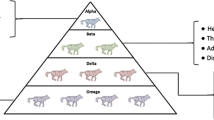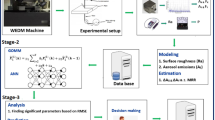Abstract
In this paper, an online grey forecasting run-to-run control system was proposed with the integration of run-to-run control system, recursive least-squares (RLS) algorithm, and grey forecasting model (GFM). One of the objectives of this study is to explore the possibility and feasibility of applying GFM to run-to-run control system in copper chemical mechanical polishing. Under the condition of limited experiment data, GFM is excellent at estimating and forecasting error of the next batch online. To keep the process under control, the controllers are then employed to adjust the process parameters in order to compensate the error. In addition, the RLS algorithm is used to construct dynamically a system estimation matrix for the purpose of stating precisely the relationship between process quality and process parameters, and to consequently improve processing performances. From the computer simulation and the experiment results, the proposed new method developed in this study was able not only to confine the processing performances’ error within the range of 5% but also to supplement, when the process parameters are saturated, the control capability through adjusting other unsaturated process parameters, thus maintaining good processing performances.
Similar content being viewed by others
References
Lakshminaryanan S (1994) Dual-Damascene copper metallization process using chemical mechanical polishing. Proceedings of the 11th International VLSI Multilevel Interconnection Conference, pp 49–55
Jackson R, Broadbent E (1998) Processing and integration of copper interconnects. Solid State Technol 41(3):49
Wang CR, Lin CF, Lin BY edit (1998) CMP Technique, Quan Hua. [Text in Chinese]
Torres J (1999) Cu dual damascene for advanced metallisation (0.18 /spl mu/m and beyond). Proceedings of the 1999 IEEE Interconnect Technology, International Conference, pp 253 –255
Wang GJ, Chou MH (2005) A neural-Taguchi-based quasi time-optimization control strategy for chemical-mechanical polishing processes. Int J Adv Manuf Technol 26(7–8):759–765
Patel N, Miller G, Guinn C, Sanchez A, Jenkins S (2000) Device-dependent control of chemical-mechanical polishing of dielectric films. IEEE Trans Semiconduct Manufact 13(3):331–343
Chen A, Guo RS (2001) Age-based double EWMA controller and its application to CMP processes. IEEE Trans Semicond Manuf 14(1):11–19
Campbell WJ, Firth SK, Toprac AJ, Edgar TF (2002) A comparison of run-to-run control algorithms. Proceedings of the 2002 American Control Conference, IEEE, New Jersey, pp 2150–2155
Yi JG, Sang WS, Zhao E (2005) A run-to-run film thickness control of chemical-mechanical planarization processes. IEEE Trans Semiconduct Manufact 6:4231–4236
Deng JL (1998) Grey theory and application. Northeast. [Text in Chinese]
Kosko B (1997) Fuzzy engineering. Prentice-Hall, Upper Saddle River, NJ
Lee WM, Liao YS (2007) Adaptive control of the WEDM process using a self-tuning fuzzy logic algorithm with grey prediction. Int J Adv Manuf Technol 34(5–6):527–537
Lin BF, Lian RJ (2006) Intelligent control of gas-assisted injection molding control systems. Int J Adv Manuf Technol 29(3–4):296–307
Ku L-L, Huang T-C (2006) Sequential monitoring of manufacturing processes: an application of grey forecasting models. Int J Adv Manuf Technol 27(5–6):543–546
Yuan H, Wang X, Zhang Z (2001) Research on the condition monitoring and predicting of the machine equipment in FMS. CIMS/FMS/MIS 20(2):1–4
Lin CT, Chang CW, Chen CB (2006) A simple approach to solving multi-response quality characteristic problems in CMOS ion implantation. Int J Adv Manuf Technol 28(5–6):592–595
Zhou Y, Chen H, Wang W, Xu X, Ding Y (2002) Interval arithmetic based on Gray model for faults diagnosis. Proceedings of the CSEE 22(6):146–151
Dong Z, Shi D, Zhang D, Yang R (2002) Online condition monitoring and fault diagnosis for group of 48MW blast furnace blowing engines. Mech Sci Technol 21(3):442–445
Luo YE (2001) Identification of genetic algorithm based on half-drive suspension neural network of grey theory. J Guizhou Univ Technol 30(4):88–96
Liu Q, Xie M, Zhong L (2002) The application of developed seeds algorithm based on grey system theory in license plate location system. J Wuhan Univ Technol 24(2):60–62
Xue M, Wang Y (1997) A discussion on CAD method for evaluation the quality of scientific papers. J Tianjin Inst Technol 13(3):86–90
Zhao D, Luo Y (1996) Evaluation LIU-Pan Mountain diversion project by multi-level grey system Theory. Water Resour Water Eng 7(2):8–15
Han TJ (1992) Adaptive control system (in Chinese). Scientific & Technical Publishing Co. Ltd.
Miwa K, Inokuchi T, Takahashi T, Oikawa A, Imaoka K (2005) Reduction of depth variation in an Si etching process by applying an optimized run-to-run control system. IEEE Trans Semiconduct Manufact 18(4):517–521
Hwang GJ (2007) Grey forecast approach for developing distance learning and diagnostic systems. IEEE Trans Syst Man Cybern Part C 37(1):98–108
Xie N, Liu S (2005) Research on discrete grey model and its mechanism. 2005 IEEE International Conference on Systems, Man and Cybernetics 1:606–610
Semitracks Inc. (2001) 21st century semiconductor technology planarization, Albuquerque, NM
Steigerwald JM, Murarka SP, Gutmann RJ, Duquette DJ (1995) An investigation of the chemical mechanical polishing of copperthin films to form in-laid interconnections in the dielectric (SiO2) films. Proceedings of the Eleventh Biennial University/ Government/ Industry Microelectronics Symposium, 1995 16(17):120–121
Chen KW, Wang YL, Liu CP, Yang K, Chang L, Lo KY, Liu CW (2004) Evaluation of advanced chemical mechanical planarization techniques for copper damascene interconnect. Thin Solid Films 447:531–536
Kao YC, Yu CC, Shen SH (2003) Robust operation of copper chemical mechanical polishing. Microelectron Eng 65(1–2):61–75
Boning S, Moyne WP, Smith TH, Moyne J, Telfeyan R, Hurwitz A, Shellman S, Taylor J (1996) Run-by-run control of chemical-mechanical polishing. IEEE Trans Components, Packaging, and Manufacturing Technology-Part c 19(4):307–314
Rao SSP, Stefani J, Comstock S, Larsen J, Paquette B, Wang M (2000) Run-to-run process control of oxide CMP using integrated metrology. Proceedings of ISSM 2000. The Ninth International Symposium on Semiconductor Manufacturing, pp 411–414
Author information
Authors and Affiliations
Corresponding author
Rights and permissions
About this article
Cite this article
Wang, GJ., Wang, MT., Yang, FC. et al. Grey forecasting run-to-run control system in copper chemical mechanical polishing. Int J Adv Manuf Technol 41, 48–56 (2009). https://doi.org/10.1007/s00170-008-1452-2
Received:
Accepted:
Published:
Issue Date:
DOI: https://doi.org/10.1007/s00170-008-1452-2




